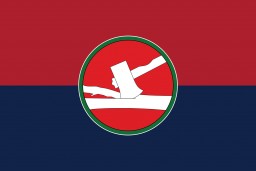You searched for: Holocaust
<< Previous | Displaying results 851-900 of 1158 for "Holocaust" | Next >>
-
Flight and Rescue
SeriesExplore the story of over 2,000 Polish Jewish refugees who fled east to escape war-torn Europe. They sought safety in such distant places as China and Japan.
-
World War I
SeriesThe trauma of WWI would profoundly shape the attitudes and actions of both leaders and ordinary people during the Holocaust. Learn more about the war and its aftermath.
-
The Role of German Professionals and Civil Leaders
SeriesDuring the Holocaust, Nazi leaders required the active help or cooperation of professionals ranging from civil servants, lawyers, doctors, teachers, police, members of the military, business elites, to church leaders. Learn more.
-
International Military Tribunal: Defendants
SeriesIn October 1945, the chief prosecutors of the International Military Trial brought charges against 24 leading German officials. Learn more about who was put on trial.
-
Young Diarists from the Lodz Ghetto
SeriesThe Jewish children of Lodz suffered unfolding harsh realities after the German invasion of Poland. Some of them, including Dawid Sierakowiak, recorded their experiences in diaries.
-
Displaced Persons Camps
SeriesLearn more about what life was like for Holocaust survivors living in DP camps after WWII. This series focuses on DP camps in the US zone of Allied-occupied Germany.
-
Pages from Stanislava Roztropowicz's Diary
Media EssayDiaries reveal some of the most intimate, heart-wrenching accounts of the Holocaust. They record in real time the feelings of loss, fear, and, sometimes, hope of those facing extraordinary peril. Stanislava Roztropowicz kept a diary from 1943-1944...

-
Children's artwork created at Weir Courtney
Media EssayAfter the war, Alice Goldberger cared for 24 refugee children at Lingfield House on the Weir Courtney Estate in England. She attempted to create a typical childhood for this group of young survivors of the Holocaust. Artwork created by the children...

-
Hoess affidavit
ArtifactAffidavit signed by Rudolf Hoess attesting to the gassing of Jews while he was the commandant of the Auschwitz killing center. The German text reads: "I declare herewith under oath that in the years 1941 to 1943 during my tenure in office as commandant of Auschwitz Concentration Camp 2 million Jews were put to death by gassing and a 1/2 million by other means. Rudolf Hoess. May 14, 1946." The confession is also signed by Josef Maier of the US Chief of Counsel's office. A photoreproduction of the original…
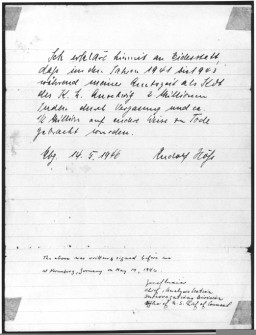
-
Granite quarried in Mauthausen
ArtifactThis photograph shows some of the 190 granite blocks donated to the United States Holocaust Memorial Museum by the Mauthausen Public Memorial in Austria. The Nazis established the Mauthausen concentration camp in 1938 near an abandoned stone quarry. Prisoners were forced to carry these granite blocks up more than 180 steps. The small blocks weighed between 30 and 45 pounds each. The larger blocks could each weigh more than 75 pounds. Prisoners assigned to forced labor in the camp quarry were quickly worked…
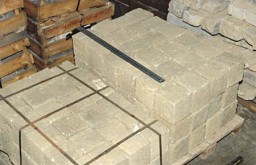
-
Playbill
ArtifactProgram for an evening performance sponsored by the Shanghai Jewish Club. The program included the play "The Day of His Return" and a concert of Jewish songs. On April 27, 1943, the day of this performance featuring Warsaw Jewish actress Raya Zomina, fierce fighting continued in the Warsaw ghetto between German troops and Jews who chose to resist Nazi efforts to liquidate the ghetto. Terrifying rumors about the Holocaust reached the Jewish refugees in Shanghai, but they did not receive reliable news or…
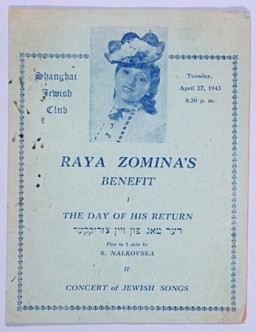
-
Hiding under a different religion
PhotoSome Jewish children survived the Holocaust because they were protected by people and institutions of other faiths. Children quickly learned to master the prayers and rituals of their "adopted" religion in order to keep their Jewish identity hidden from even their closest friends. This photograph shows two hidden Jewish children, Beatrix Westheimer and her cousin Henri Hurwitz, with Catholic priest Adelin Vaes, on the occasion of Beatrix's First Communion. Ottignies, Belgium, May 1943.
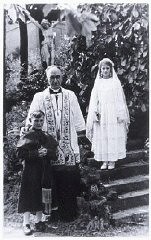
-
Armenian deportees
PhotoA small group of Armenian deportees walking through the Taurus Mountain region, carrying bundles. A woman in the foreground carries a child. Ottoman Empire, ca. November 1915. Photograph taken by Armin T. Wegner. Wegner served as a nurse with the German Sanitary Corps. In 1915 and 1916, Wegner traveled throughout the Ottoman Empire and documented atrocities carried out against the Armenians. [Courtesy of Sybil Stevens (daughter of Armin T. Wegner). Wegner Collection, Deutsches Literaturarchiv, Marbach…

-
Barbed-wire fence separating the Krakow ghetto from the rest of the city
PhotoView of a barbed-wire fence separating part of the ghetto in Krakow from the rest of the city. Krakow, Poland, date uncertain. During the Holocaust, the creation of ghettos was a key step in the Nazi process of brutally separating, persecuting, and ultimately destroying Europe's Jews. Ghettos were often enclosed districts that isolated Jews from the non-Jewish population and from other Jewish communities.
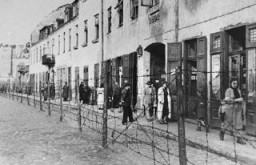
-
Hainichen
ArticleIn 1933, the Nazis established the Hainichen labor camp in Sachsen, Germany. Learn more about the camp, its closing, and the prisoners.
-
Theresienstadt: Cultural Life
ArticleDespite terrible living conditions and the constant threat of deportation, there was a highly developed cultural life in the Theresienstadt camp-ghetto. Learn more.
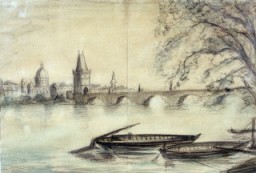
-
Third Reich: An Overview
ArticleThe Third Reich began with the Nazi rise to power in 1933 and ended with the German surrender in 1945. Learn more about Nazi Germany during World War II.
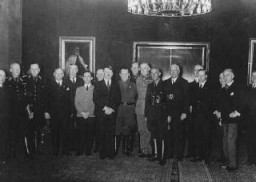
-
Minsk
ArticleIn 1941, the Nazis occupied Minsk and established a ghetto there. Learn more about life in Minsk during World War II.
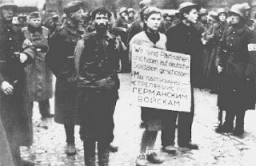
-
Siege (1940)
ArticleJulien Bryan’s ten-minute film Siege, first non-Nazi produced footage of the start of WWII, records horror and chaos in Warsaw following the German invasion.

-
Exodus 1947
ArticleThe plight of Jewish refugees aboard the Exodus 1947 captured the world's attention and symbolized the struggle for unrestricted immigration into Palestine.
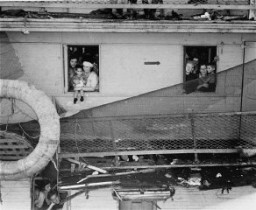
-
Belgium
ArticleThe Germans conquered Belgium in May 1940. Learn about the occupation, anti-Jewish laws and ordinances, detention camps, and deportations of Jews from Belgium.

-
Writers and Poets in the Ghettos
ArticleSongs, verses, and writings of writers and poets in the ghettos reflect efforts to preserve culture, humanity, and documentation, as well as acts of defiance. Explore examples.
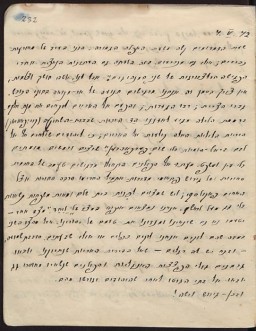
-
Ben Hecht
ArticleAmerican-Jewish journalist and author Ben Hecht co-wrote the We Will Never Die pageant and advocated for the rescue of Jewish victims from Nazism. Learn more.
-
Alexander White
ArticleRead the Jewish Partisan Educational Foundation's short biography of Alexander White.

-
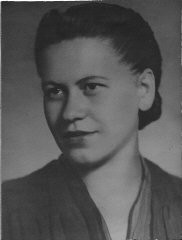
-
The Role of Business Elites
ArticleTo implement their policies, the Nazis had help from individuals across Europe, including professionals in many fields. Learn about the role of business elites.

-
View of a burial site in Nyanza, Rwanda
PhotoNyanza is a site near Kigali, Rwanda, where several thousand people were executed after being marched from the Belgian Technical School in April 1994. At the school, they had been under the protection of UN peacekeepers until the soldiers were recalled to the airport to help evacuate expatriates. This is one of the few sites where victims had the honor of individual burial; most often they were buried together in large graves. Photograph taken on November 24, 2007. United States Holocaust Memorial Museum

-
Massacre in Fort IX
Timeline EventOctober 29, 1941. On this date, German SS and police and Lithuanian police murdered 9,200 residents of the Kovno ghetto in Fort IX, Lithuania.

-
Flag graphic for the US 101st Airborne Division
PhotoA digital representation of the United States 101st Airborne Division's flag. The US 101st Airborne Division (the "Screaming Eagles" division) was established in 1942. During World War II, they were involved in D-Day and the Battle of the Bulge. The division also captured the city of Eindhoven and uncovered the Kaufering IV camp. The 101st Airborne Division was recognized as a liberating unit in 1988 by the United States Army Center of Military History and the United States Holocaust Memorial Museum…

-
Flag graphic for US 103rd Infantry Division
PhotoA digital representation of the United States 103rd Infantry Division flag. The US 103rd Infantry Division (the "Cactus" division) was established in 1942. During World War II, they were involved in the Battle of the Bulge and captured the city of Innsbruck. The division also uncovered a Nazi subcamp attached to Kaufering camp complex. The 103rd Infantry Division was recognized as a liberating unit in 1985 by the US Army's Center of Military History and the United States Holocaust Memorial Museum…

-
Flag graphic for US 104th Infantry Division
PhotoA digital representation of the United States 104th Infantry Division's flag. The US 104th Infantry Division (the "Timberwolf" division) was activated in 1942. During World War II, they captured the cities of Cologne and Halle. The division also overran Nordhausen and the Dora-Mittelbau concentration camp. The 104th Infantry Division was recognized as a liberating unit in 1988 by the United States Army Center of Military History and the United States Holocaust Memorial Museum (USHMM).
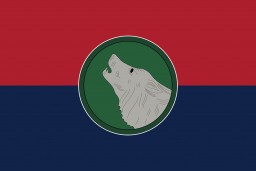
-
Flag graphic for US 10th Armored Division
PhotoA digital representation of the United States 10th Armored Division's flag. The US 10th Armored Division is also known as the "Tiger" division. During World War II, they captured the cities of Trier and Oberammergau. The division also overran a Dachau subcamp. The 10th Armored Division was recognized as a liberating unit in 1985 by the United States Army Center of Military History and the United States Holocaust Memorial Museum (USHMM).

-
Flag graphic for US 11th Armored Division
PhotoA digital representation of the United States 11th Armored Division's flag. The US 11th Armored Division (the "Thunderbolt" division) was formed in 1942. During World War II, they were involved in the Battle of the Bulge and captured the cities of Coburg, Bayreuth, and Linz. The division also overran the Mauthausen and Gusen concentration camps. The 11th Armored Division was recognized as a liberating unit in 1985 by the United States Army Center of Military History and the United States Holocaust…
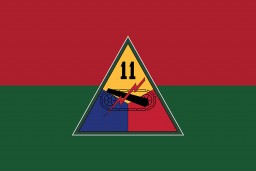
-
Flag graphic for US 12th Armored Division
PhotoA digital representation of the United States 12th Armored Division's flag. The US 12th Armored Divison is also known as the "Hellcats" division. During World War II, they captured the cities of Ludwigshafen and Würzburg. The division also overran a subcamp of Dachau. The 12th Armored Division was recognized as a liberating unit in 1988 by the United States Army Center of Military History and the United States Holocaust Memorial Museum (USHMM).
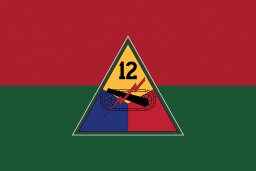
-
Flag graphic for US 14th Armored Division
PhotoA digital representation of the United States 14th Armored Division's flag. The US 14th Armored Division (the "Liberators" division) joined the war in 1944. During World War II, they uncovered several subcamps of Dachau, three large forced-labor camps, and several other nearby camps. The 14th Armored Division was recognized as a liberating unit in 1991 by the United States Army Center of Military History and the United States Holocaust Memorial Museum (USHMM).
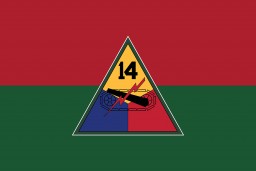
-
Flag graphic for US 26th Infantry Division
PhotoA digital representation of the United States 26th Infantry Division's flag. The US 26th Infantry Division (the "Yankee" division) was formed in 1917 and fought in World War I. During World War II, they were involved in the Battle of the Bulge and captured the city of Linz. The division also overran the Gusen concentration camp. The 26th Infantry Division was recognized as a liberating unit in 2002 by the United States Army Center of Military History and the United States Holocaust Memorial Museum…
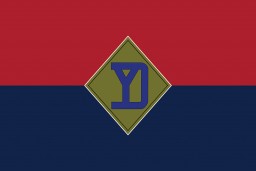
-
Flag graphic for US 29th Infantry Division
PhotoA digital representation of the United States 29th Infantry Division's flag. The US 29th Infantry Division (the "Blue and Gray" division) was established in 1917 and fought in World War I. During World War II, they were involved in D-Day, as well as the liberation of Dinslaken civilian labor camp. The 29th Infantry Division was recognized as a liberating unit in 1995 by the United States Army Center of Military History and the United States Holocaust Memorial Museum (USHMM).

-
Flag graphic for US 30th Infantry Division
PhotoA digital representation of the United States 30th Infantry Division's flag. The US 30th Infantry Division (the "Old Hickory" division) was established in 1917 and fought in World War I. During World War II, they were involved in the Battle of the Bulge and also liberated Weferlingen, a subcamp of Buchenwald. The 30th Infantry Division was recognized as a liberating unit in 2012 by the United States Army Center of Military History and the United States Holocaust Memorial Museum (USHMM).
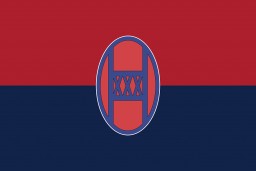
-
Flag graphic for US 36th Infantry Division
PhotoA digital representation of the United States 36th Infantry Division's flag. The US 36th Infantry Division (the "Texas" or "Lone Star" division) was established in 1917 and fought in World War I. During World War II, they were involved in the Allied invasions of North Africa and the Battle of the Bulge. The division also overran some of the Kaufering subcamps of the Dachau concentration camp. The 36th Infantry Division was recognized as a liberating unit in 1995 by the United States Army Center of…
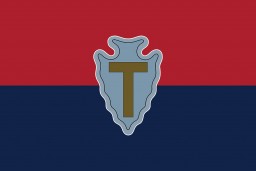
-
Flag graphic for US 3rd Armored Division
PhotoA digital representation of the United States 3rd Armored Division's flag. The US 3rd Armored Division (the "Spearhead" division) was established in 1941. During World War II, they were involved in the Battle of the Bulge and captured the city of Cologne. The division also discovered the Dora-Mittelbau concentration camp. The 3rd Armored Division was recognized as a liberating unit in 1985 by the United States Army Center of Military History and the United States Holocaust Memorial Museum (USHMM).
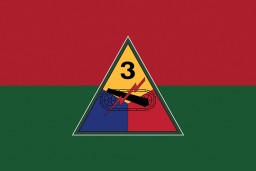
-
Flag graphic for US 42nd Infantry Division
PhotoA digital representation of the United States 42nd Infantry Division's flag. The US 42nd Infantry Division (the "Rainbow" division) was established in 1917 and fought in World War I. During World War II, they captured the cities of Würzburg, Schweinfurt, and Fürth. The division also entered the Dachau concentration camp. The 42nd Infantry Division was recognized as a liberating unit in 1985 by the United States Army Center of Military History and the United States Holocaust Memorial Museum…
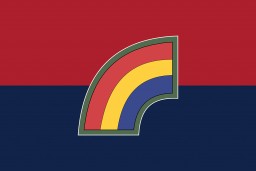
-
Flag graphic for US 45th Infantry Division
PhotoA digital representation of the United States 45th Infantry Division's flag. The US 45th Infantry Division (the "Thunderbird" division) was established in 1924. During World War II, they were involved in the Allied invasions of North Africa and Italy, as well as the capture of the city of Nuremberg. The division also liberated the Dachau concentration camp. The 45th Infantry Division was recognized as a liberating unit in 1985 by the United States Army Center of Military History and the United States…
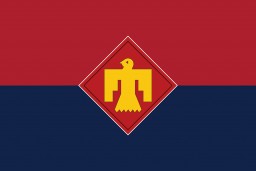
-
Flag graphic for US 4th Infantry Division
PhotoA digital representation of the United States 4th Infantry Division's flag. The US 4th Infantry Division (the "Ivy" division) was established in 1917 and fought in World War I. During World War II, they were involved in D-Day, the liberation of Paris, and the Battle of the Bulge. The division also captured the city of Nuremberg and discovered a Dachau subcamp near Haunstetten. The 4th Infantry Division was recognized as a liberating unit in 1992 by the United States Army Center of Military History and…

-
Flag graphic for US 65th Infantry Division
PhotoA digital representation of the United States 65th Infantry Division's flag. The US 65th Infantry Division (the "Battle Axe" division) was established in 1943. During World War II, they took the cities of Regensburg, Passau, and Linz. The division also overran a subcamp of the Flossenbürg concentration camp. The 65th Infantry Division was recognized as a liberating unit in 1994 by the United States Army Center of Military History and the United States Holocaust Memorial Museum (USHMM).
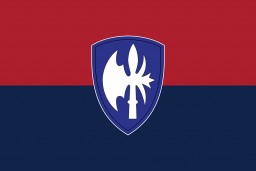
-
Flag graphic for US 69th Infantry Division
PhotoA digital representation of the United States 69th Infantry Division's flag. The US 69th Infantry Division ("Fighting 69th") was established in 1943. During World War II, they captured the city of Leipzig and uncovered Leipzig-Thekla, a subcamp of Buchenwald. The 69th Infantry Division was recognized as a liberating unit in 1993 by the United States Army Center of Military History and the United States Holocaust Memorial Museum (USHMM).

-
Flag graphic for US 71st Infantry Division
PhotoA digital representation of the United States 71st Infantry Division's flag. The US 71st Infantry Division (the "Red Circle" division) was established in 1943. During World War II, they were involved in taking the cities of Coburg, Bayreuth, and Regensburg. The division also liberated Gunskirchen, a subcamp of Mauthausen. The 71st Infantry Division was recognized as a liberating unit in 1988 by the United States Army Center of Military History and the United States Holocaust Memorial Museum (USHMM).
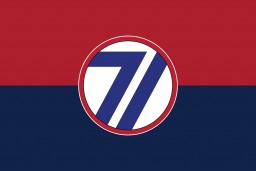
-
Flag graphic for US 80th Infantry Division
PhotoA digital representation of the United States 80th Infantry Division's flag. The US 80th Infantry Division (the "Blue Ridge" division) was established in 1917 and fought in World War I. During World War II, they were involved in the Battle of the Bulge. The division entered Buchenwald concentration camp and liberated Ebensee, a subcamp of Mauthausen. The 80th Infantry Division was recognized as a liberating unit in 1985 by the United States Army Center of Military History and the United States Holocaust…
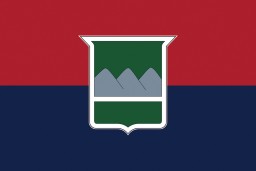
-
Flag graphic for US 82nd Airborne Division
PhotoA digital representation of the United States 82nd Airborne Division's flag. The US 82nd Airborne Division (the "All American" division) was established in 1918 and fought in World War I. During World War II, they were involved in D-Day and Battle of the Bulge. The division also overran Wöbbelin, a subcamp of Neuengamme. The 82nd Airborne Division was recognized as a liberating unit in 1991 by the United States Army Center of Military History and the United States Holocaust Memorial Museum (USHMM).
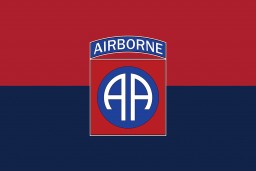
-
Flag graphic for US 83rd Infantry Division
PhotoA digital representation of the United States 83rd Infantry Division's flag. The US 83rd Infantry Division (the "Thunderbolt" division) was established in 1917 and fought in World War I. During World War II, they were involved in the Battle of the Bulge and captured the city of Halle. The division also encountered Langenstein, a subcamp of Buchenwald. The 83rd Infantry Division was recognized as a liberating unit in 1993 by the United States Army Center of Military History and the United States…
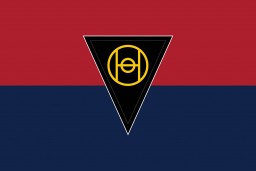
-
Flag graphic for US 84th Infantry Division
PhotoA digital representation of the United States 84th Infantry Division's flag. The US 84th Infantry Division (the "Railsplitter" division) was established in 1917. During World War II, they were involved in the Battle of the Bulge and captured the city of Hannover. The division also uncovered Hannover-Ahlem and Salzwedel, two satellite camps of the Neuengamme concentration camp. The 84th Infantry Division was recognized as a liberating unit in 1993 by the United States Army Center of Military History and…
